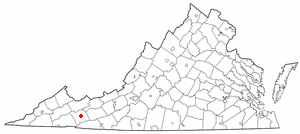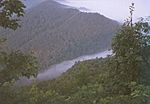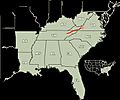Battle of Marion facts for kids
Quick facts for kids Battle of Marion |
|||||||||
|---|---|---|---|---|---|---|---|---|---|
| Part of Stoneman’s Raid into Southwest Virginia | |||||||||
 Location of the battle |
|||||||||
|
|||||||||
| Belligerents | |||||||||
| Union | Confederacy | ||||||||
| Commanders and leaders | |||||||||
| George Stoneman | John C. Breckinridge | ||||||||
| Casualties and losses | |||||||||
| 154 | 120 | ||||||||
The Battle of Marion (December 17–December 18, 1864) was a military engagement in the American Civil War that occurred when Major General George Stoneman, commander of the Union Army in Kentucky and Tennessee, raided Southwestern Virginia. General Stoneman's plan was to destroy anything that might benefit the Southern war effort and was approved by his commanding officers on December 6, 1864.
The Confederates managed to hold the key positions on the battlefield against numerous Union charges. Eventually, the Confederates ran short of ammunition and were forced to withdraw. The total casualties for this battle were 274, relatively low for a battle during the Civil War.
After the battle, the Union expedition set out to destroy the salt mines, lead works, and anything else in the area that could be of benefit to the Confederates.
Contents
Location
The town of Marion is in southwest Virginia on the Middle Fork of the Holston River in Smyth County, Virginia. It was about half way between the salt works at Saltville and the lead mines near Wytheville. Since it is near the Mason–Dixon line, many of the town's families were divided and fought on opposing sides. Until the winter of 1864, the town of Marion had been protected from fighting by the mountains and geographic location.
Background
Union army
Proposition
Major General George Stoneman, commander of the Union Army in Kentucky and Tennessee, proposed another expedition into southwest Virginia to destroy all facilities and supplies of benefit to the Confederate war effort. This gained the approval of Major General John Schofield on December 6, 1864.
Preparations
Stoneman would use troops under General Alvan Gillem and those commanded by General Stephen Burbridge—including the 5th and the 6th U.S. Colored Cavalry who had participated in the failed previous attempt to destroy the salt works at the first Battle of Saltville. Stoneman ordered Burbridge to bring his army of 4,200 men through the Cumberland Gap to join Stoneman and General Gillem at Knoxville, Tennessee where Gillem was refitting his own command into a picked force of 1,500 men. Stoneman did not reveal the objectives of the expedition to his subordinates until three days after it had departed Knoxville on December 10. On December 12, Stoneman's force flanked and forced back Confederate General Basil Duke's cavalry at Rogersville, Tennessee. The Federals defeated and scattered the Confederates the next day at Kingsport, Tennessee. There General Gillem captured 84 prisoners, including Col. Richard C. Morgan and the brigade's supply train.
On the 14th, the Union army began to push Duke's cavalry back toward Abingdon, Virginia. The next day, Stoneman and his cavalry went into camp at Glade Spring, Virginia, which was about 13 miles (21 km) west of Marion. On December 16, Stoneman's cavalry rode toward Marion, destroying infrastructure and public buildings along their path.
Confederate army
The opposing force of General Stoneman was the army of Major General John C. Breckinridge, who was the commander of the Department of Southwest Virginia. Breckinridge's command consisted of approximately 1,000 regular troops with another 500 militia reserves. Most of the army had been transferred to the Army of Northern Virginia to help in the defense of Richmond.
Preparations
Breckinridge's army consisted of Colonel Henry Giltner's brigade, (which was formed from the soldiers of the 4th Kentucky Cavalry and the 10th Kentucky Cavalry); the 10th Kentucky Mounted Rifles (later renamed to the 13th Kentucky Cavalry), and the 64th Virginia Mounted Infantry. Breckinridge's army also included General Basil Duke's cavalry, General George Cosby's cavalry and Colonel Vincent Witcher and his 34th Battalion of Virginia Cavalry.
On the night of December 16, General Breckinridge and his troops moved out of Saltville, Virginia in an effort to stop Stoneman. Taking the regular troops with him, Breckinridge left Colonel Robert Preston in charge of the 500 militia men to defend the salt works. General Breckinridge sent Witcher and his men of the 34th on ahead of his main force and ordered them to harass the Union army.
At about 3 a.m. (Local Time), Breckinridge and his small army began to travel across Walkers Mountain. In the last few days before the march, 4" of rain fell, making travel difficult across the muddy roads. At 4:00 a.m. (Local Time), they reached the main road near Seven Mile Ford, Virginia where Breckinridge waited for daylight before continuing.
Battle
Advance
Around noon of December 17, 1864, Breckinridge's men mounted their horses rode toward Marion. Meanwhile, General Stoneman sent some of his Tennessee regiments to Wytheville, Virginia to destroy anything that looked valuable. Stoneman also sent two regiments of cavalry to destroy the lead mines and smelting facilities that were about ten miles (16 km) from Wytheville.
Stoneman and Burbridge continued on toward Marion where they encountered Witcher and his men. Burbridge's front regiment easily pushed back Witcher's small regiment, who stopped just so they could fire a volley into the Union cavalry. They then continued to retreat toward Marion. Witcher sent a courier to inform Breckinridge that they were coming to join them at Marion.
First day
General Breckinridge's front regiment was the 10th Kentucky Mounted Rifles, under the command of Colonel Benjamin Caudill. Caudill's men dismounted and fired into the Union cavalry, causing several casualties. As the rest of Breckinridge's troops began to arrive on the scene, General Stoneman's men secured the high hill overlooking the river. Breckinridge observed that these hills were the best defensive positions in the area; following which he ordered the men of the 10th Kentucky Mounted Rifles to charge up the hill and drive out the Union army. The rest of Giltner's Brigade also joined in the charge, routing the Union soldiers. The result of the charge ended in Confederate favor, and the Confederates gained control of the hill.
Burbridge then began to form his men up in columns to counterattack the Rebel defenses. As soon as the men were in position, he ordered all columns to charge in unison. After the signal, the Union Army surged forward. The first Confederate volley of shots depleted the Union forces considerably. Even after the volley, the Rebel forces were still vastly outnumbered. Confederate Artillery commander Major Richard Page and his battery of four 10-pounder Parrott rifles began to fire, attempting to slow the charge. The overwhelming fire forced the Union soldiers to fall back with many casualties.
The Union officers then reorganized their men and with a yell of their own, charged again. Like the previous charge, this charge also was repelled. One more charge occurred that day. Courageously, the men formed and prepared to face the withering fire that they knew would come from the breast works in their front. For the final time that day, the Union army charged into Confederate fire with the same results as the previous charges. The Rebels had held on to their position during the first day of battle.
Breckinridge ordered his men to move forward and build new breastworks. These new defensive positions placed the two armies less than one hundred fifty yards apart. During the night, one Union officer was ordered to take positions at the covered bridge near the river. He and 75 men took up positions in and around the covered bridge. This was the only advance of that night by the Union army.
Second day
The Union army that was positioned at the covered bridge fired the first few volleys at the rebels to harass their front positions. General Burbridge attacked just as the fog lifted. To entertain themselves, soldiers from both armies began to hurl insults across the fields between them. About midmorning Burbridge decided that the light rain probably would not stop falling any time soon and had his officers prepare to commence the battle.
Both armies yet again raised their battle cries. Columns of Union men charged across the fields into the same fire they had received the day before. A combination of the colored and the white troops managed to push the 4th Kentucky Infantry and General Cosby's positions back. Cosby rallied his men and counterattacked, retaking their breastworks. The Union soldiers that had taken positions at the covered bridge the night before began to take pressure from the 4th Kentucky in their front. They realized their location was not safe one and some began to try to run back to the Union lines. As these men would attempt to retreat from their positions at the bridge, the rebels of the would pick most of them off. The remaining Union soldiers at the bridge decided to wait out the battle. Later in the day General Burbridge ordered one of his regiments to charge across the bridge on horseback to relieve the pressure on the trapped men. The regiment solely received a few casualties and then retreated.
On the far right, General Duke was being pressed hard by the heavy columns of attacking soldiers. Seeing this, Colonel Giltner sent his regiment to reinforce Duke. Before the 2nd arrived, Duke and his men counterattacked the Union line and routed it. Duke and Witcher then combined forces and charged the Union's extreme left flank. This Union colored regiment was also completely routed.
Burbridge and his men then went into a disorderly retreat. The confederate rail breastworks had held, but the holding of the line had resulted in the use of a huge amount of ammunition. Each Rebel defender had shot at least seventy-five rounds, and some having fired as many as a hundred shots. The Union army then ordered another charge with a large cavalry regiment that reinforced the Union infantry. The unexpected fighting capabilities of the small Confederate army had temporarily created a reprieve for the salt works.
Aftermath
Breckinridge ordered his field officers to make an inspection of the troops and to report back with the condition of his army. The number of men wounded and killed had depleted his army to the point that he could judged that he could no longer hold back the Union army at the front lines. Ammunition in the camp was also running low; each man had no more than ten cartridges apiece. With their supplies destroyed by Stoneman's army at the towns of Wytheville and Abingdon, there was little hope of being resupplied or reinforced in time.
Breckinridge then ordered his men to retreat from the battlefield. Though the men faced miserable conditions, they were confident they could hold the field the next day. Angrily they obeyed orders and silently began to move out with Colonel Ben Caudill and his Mounted Rifles leading the way.
Outcome
The battle at Marion was a Union victory. The vastly outnumbered Rebels had inflicted moderate casualties and slowed the advance on Saltville, but were unable to stop it. Finding their own path to Saltville's defenses blocked, Breckinridge and his men retreated further south, while the Union raiders advanced. Saltville would fall to a night attack on December 20 - December 21 and the salt works would be destroyed by the Union army.
The damage to the leadmines near Wytheville would keep them out of production for three months, and then only partial production would be possible. Salt production would not be resumed for over a month. All railroad locomotives, cars, depots and bridges in the vicinity had been destroyed by the raid. General Stoneman claimed to have captured 34 officers and 845 enlisted men during the raid.
Images for kids
-
Stoneman's advance toward Marion, Virginia.








